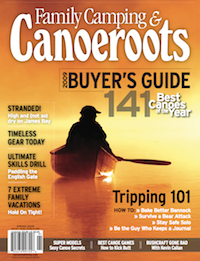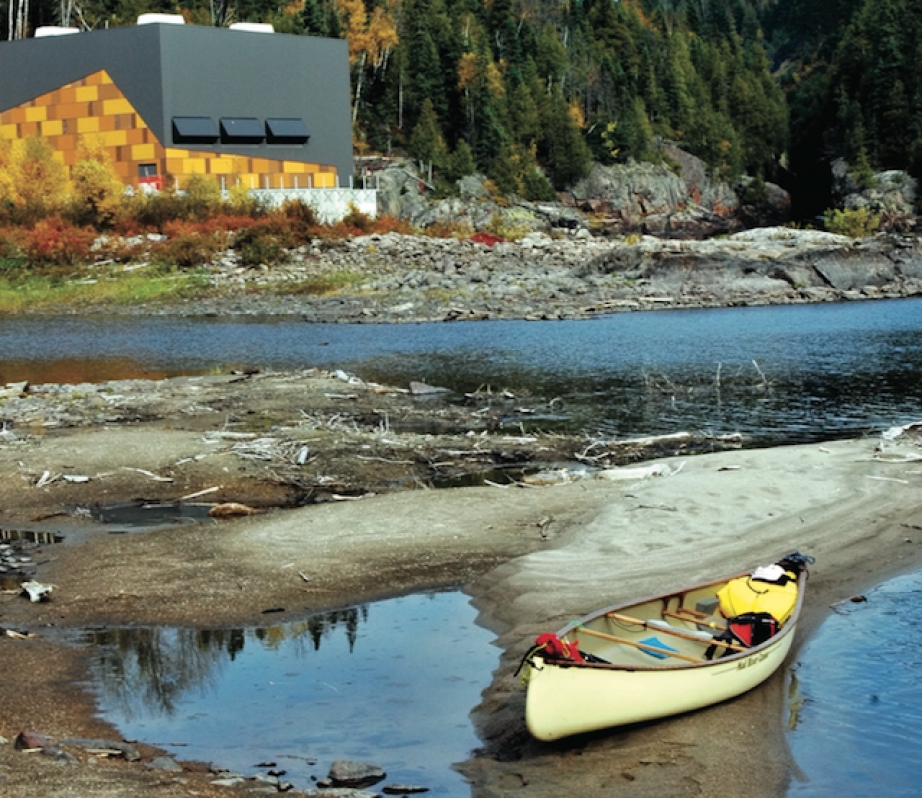On a river in the boreal forest of northern Ontario, I couldn’t stop thinking about the American Southwest. In the late 1950s, legendary writer Edward Abbey took a final raft trip down the wild Glen Canyon, just before a dam closed the Colorado River in 1963 and formed placid, sterile Lake Powell. Abbey immortalized the paradisiacal Canyonlands in his essays and helped usher in the radical environmental movement with his novel The Monkey Wrench Gang, in which protagonist George Washington Hayduke plots to blow up the Glen Canyon dam.
Lake Superior’s White River is suffering a similar fate to Abbey’s Colorado—albeit at a smaller scale. I first paddled the White a decade ago, when the threat of hydroelectric development along its course was mere hearsay. I remember a series of runnable rapids, cascading falls and calm meanders interspersed with a healthy number of portages and granite and sand campsites. The highlight of the trip was Umbata Falls, where my friend Chris and I white-knuckled our way into an eddy at the lip, deafened by the roar of the 30-metre drop. We then shouldered our gear and followed an ancient, faintly marked, ankle-twisting portage, enjoying slack- jaw views from the rim of the billowing canyon.
I vowed to never paddle the White River again when I learned in 2003 that a local Pic River Ojibway band had partnered with a developer to build a dam and hydroelectric generating station at Umbata. The project was approved in spite of the White’s 1999 designation as a provincial waterway park; the government said it had to keep a 1993 promise to reserve Umbata and two other falls on the river for hydropower.
Hydropower catchwords like “green”and “renewable” don’t soften the loss of some of Canada’s finest wilderness rivers
Curiosity eventually led me to the developer’s website, which showed aerial photos with schematic overlays of rubber weirs, impoundment areas and an underground penstock that would burrow beneath the old portage trail and channel the river’s flow into twin turbines. I heard that an all-terrain vehicle shuttle had replaced the portage around the Umbata construction site. I wrote a lengthy, passionate letter to my MPP, and received a stock reply in return.
Countless smaller, “run of the river” projects like Umbata, and larger, Hydro Quebec-style mega-developments could become even more common on Canada’s rivers in the years to come, especially if Transport Canada gets away with gutting the Navigable Waters Protection Act. In a 2005 report, Ontario’s electricity planning agency highlighted 190 potential waterpower sites across the province.
It’s true that in the age of climate change, harnessing the low-emissions energy of falling water sounds like a logical way to meet electricity needs. But the trouble is, argue environmentalists like Janet Sumner, the executive director of CPAWS Wildlands League, feeding the grid with more hydroelectricity does nothing to curb our swelling appetite for power. Hydropower catchwords like “green”and “renewable” don’t soften the loss of some of Canada’s finest wilderness rivers.
In the spirit of “salvage tourism”—like Abbey on the Colorado or the growing list of adventurers racing to be the last to see land- scapes imperiled by climate change, mineral development and urban sprawl—I convinced myself to make a final run on the White River. I’d get off the river two days before its flow was shunted and Umbata’s powerhouse turbines spun for the first time.
The first few days of the 85-kilometre-long trip were much the way I remembered. I crashed through chutes of whitewater and snuck by a moose with platter-sized antlers in a backwater lagoon. I spent my nights in copses of spruce and cedar. With the excep- tion of a few obnoxious ribbons of orange flagging tape marking two other potential hydro sites that the Ontario Ministry of Natural Resources has issued to another First Nation, I saw nothing calling for Hayduke-like ecotage.
We reached Umbata at lunch on day three. The traditional portage at the precipice of the falls had been rerouted to follow 2.5 kilometres of logging roads, far beyond the sights and sounds of the falls and canyon.
I carried my canoe past clearcuts, transmission corridors and mounds of pulverized bedrock. But descending the final grade to the river, the relief I normally feel at the end of a portage was absent. A thin veil of poplar barely hid a box store-sized generating structure. In behind, the dark, ominous maw of the canyon was diminished.
I wanted to erupt—to attack the monstrous powerhouse with obscenities and rocks.
My thoughts swung to Hayduke: “Freedom, not safety, is the highest good.” But it was too late to fight for the White’s freedom, and I couldn’t stand to stick around. I don’t care if Outside magazine has called it the “new” thing. There’s no satisfaction in salvage tourism; no sense of accomplishment in being the final person to paddle the White River before turbines spin, power lines hum and Umbata runs dry. I’d rather wait as long as it takes to be the first to paddle it again when energy conservation has rendered the dam unnecessary. Faraway, in the American Southwest, Abbey’s beloved Canyonlands could one day reappear, as Lake Powell levels continue to drop to feed thirsty desert metropolises, leaving the Glen Canyon dam higher and drier every year. Perhaps a similar but more noble salvation awaits the White.
I loaded my canoe and ran the next set of rapids blind, backpaddling, drawing and cleanly missing pillow rocks and grabby holes. Downstream, the last wild stretch of the White River beckoned. Digging deep, I wondered if our demand for power could ever truly be more powerful than a river. But I don’t have an answer yet.

This article first appeared in the Spring 2009 issue of Canoeroots Magazine.



